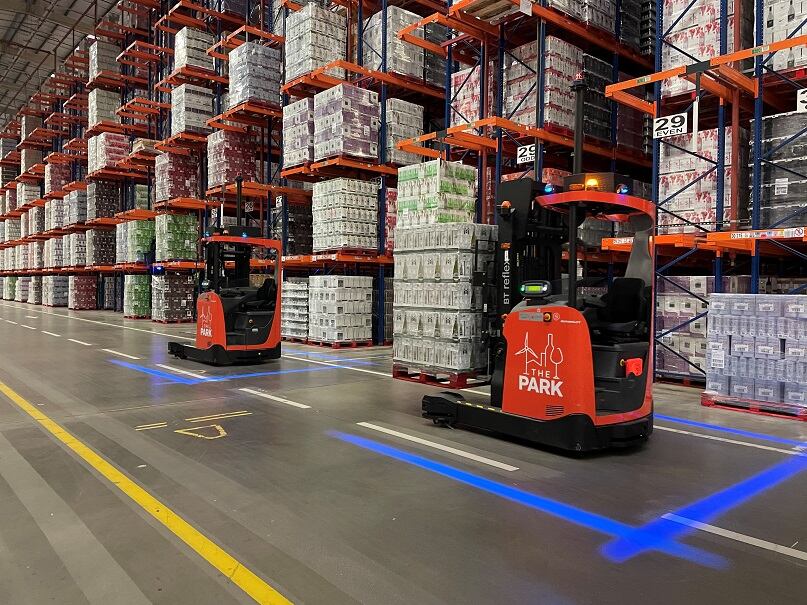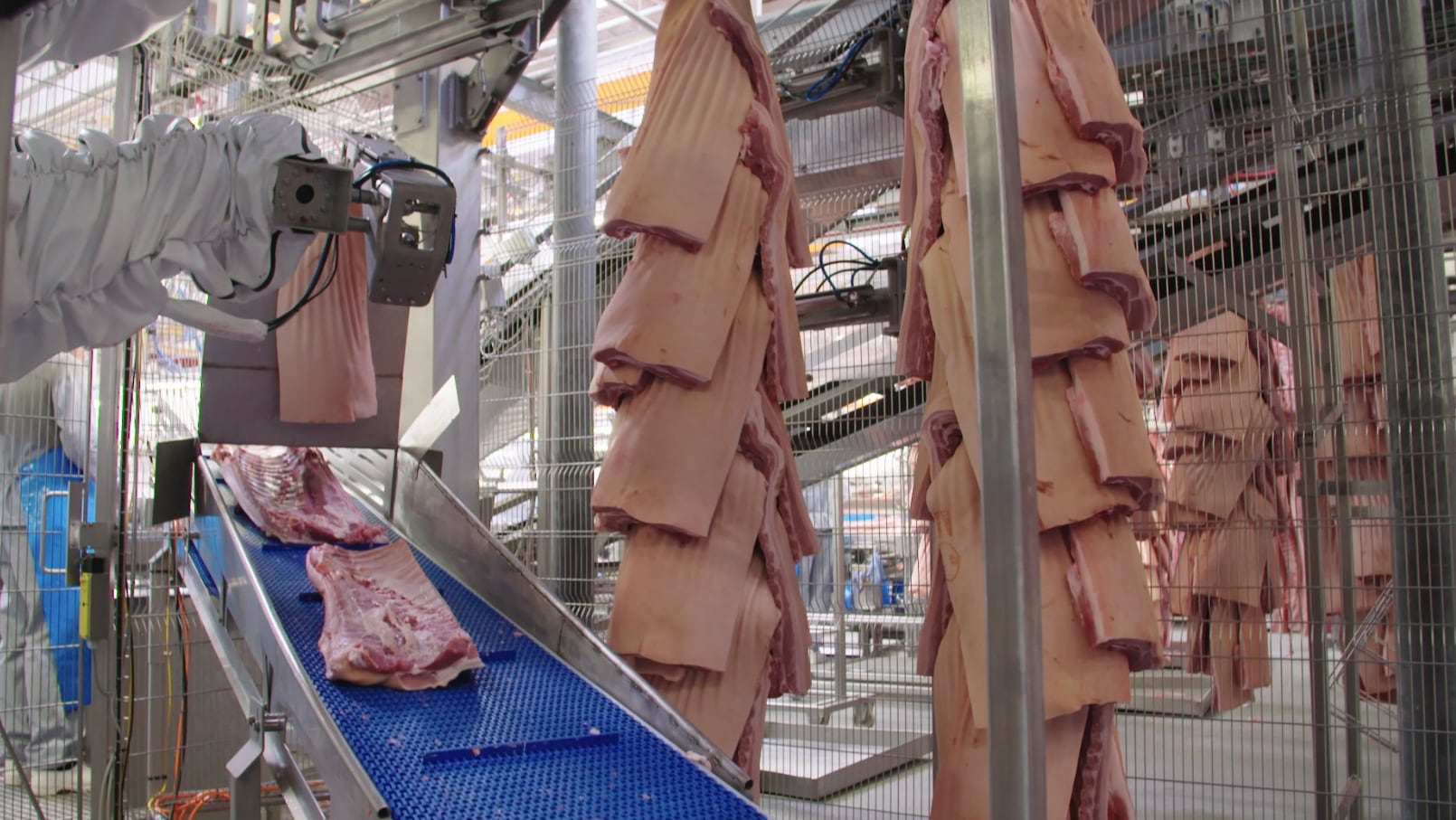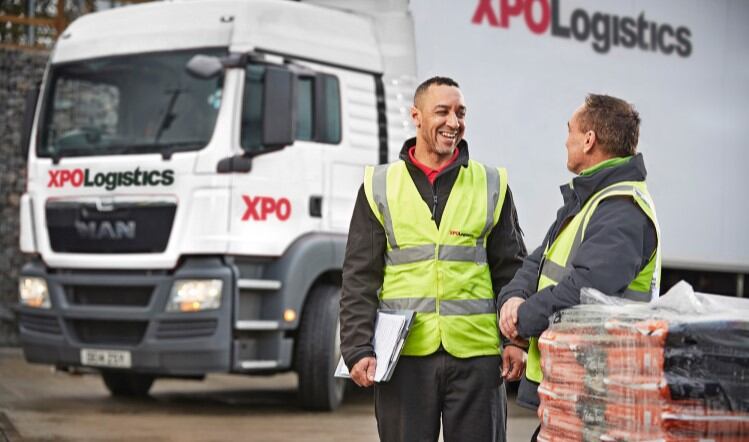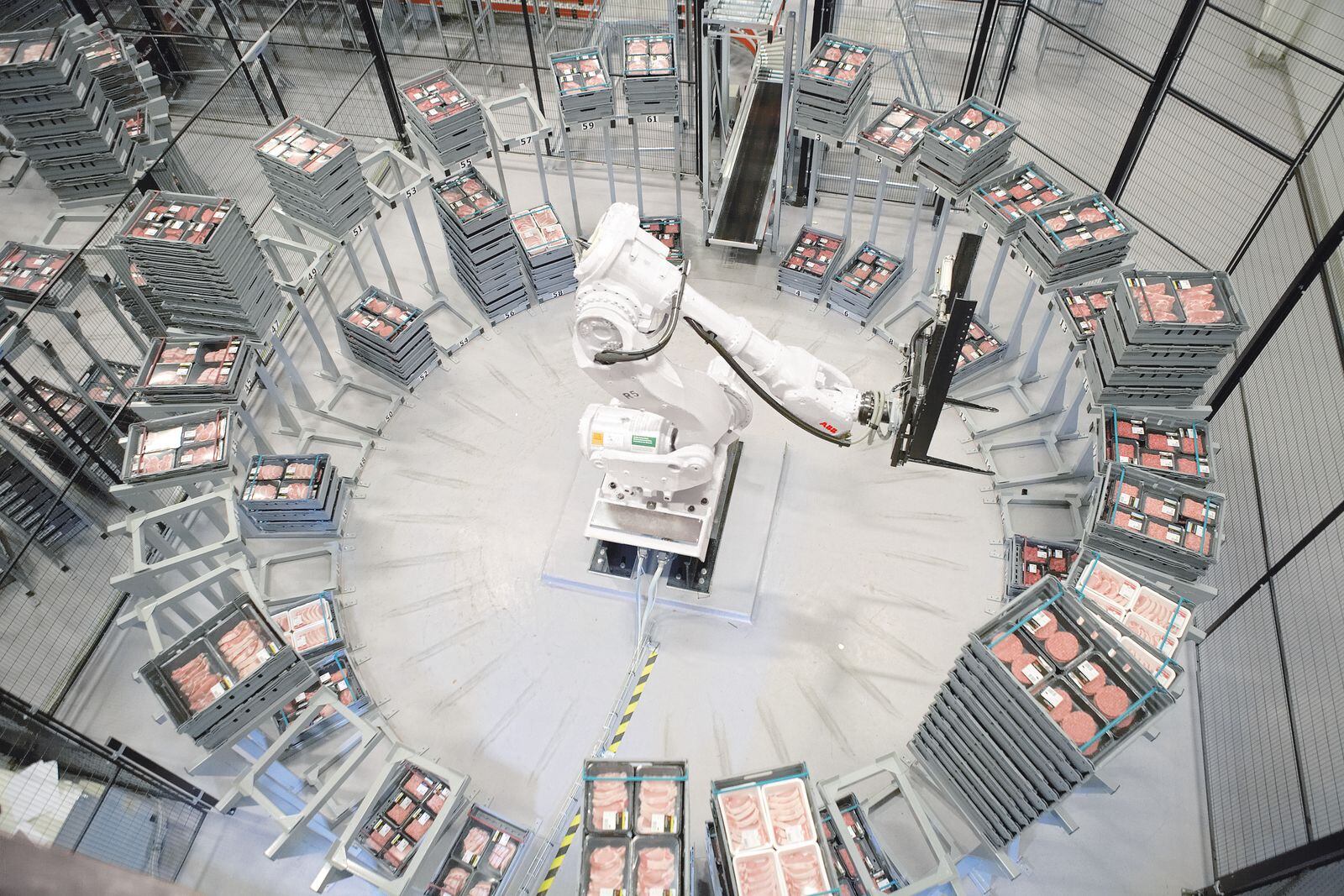Technology is constantly evolving to address the needs of a sector that's about so much more than palletising, intralogistics and warehousing.
Materials handling and storage embraces all instances in which food and drink is directly handled or stored in factories, silos or warehousing space, from conveying to 'pick and place' robots to automated guided vehicles.
And as always, there's been a fair amount of innovation in the past year to deal with perennial issues - one of which is health & safety. The automation of manual handling tasks can dramatically reduce injuries caused by heavy lifting, for example.
Danish Crown
Just today (8 July), Danish Crown announced a planned multi-million pound roll out of a robot currently being tested at its abattoir in Blans, Denmark. The robot can handle all parts of pig carcasses in both dismantling and hanging, making it unnecessary for production line employees to heft cuts that can weigh up to 15kg.
The plan is for similar robots to be installed at all Danish Crown's Danish pig abattoirs by 2026 - costing what the company confirms is three-digit million DKK.
"The abattoir industry continues to work very hard," says Rikke Dencher Aagaard, director of working environment at Danish Crown, who also points out that rotations between tasks at abattoirs is vital to minimise heavy lifting. "Therefore, we have a huge responsibility to reduce, and in the long run completely eliminate, physically strenuous work tasks at the abattoir.
"We must be able to offer jobs where one can work for an entire working life without being worn down. The new robot is a big step in the right direction because it removes many of the heavy lifts that put a heavy strain on the shoulders and elbows in particular."
Not only do such solutions improve health & safety, making workers' lives easier and boosting staff retention, but in automating a previously manual process they also potentially require fewer staff. That helps manufacturers tackle the shortage of skilled and unskilled personnel.
Similar tech is available in bakery. Also from Denmark, and in collaboration with Danmatic, a leading company specialising in the design and production of bakery and other food processing equipment, Gripwiq has developed a new gripping system for de-panning loaves for family-owned bakery Jensen Bread.
The newly-installed machine can de-pan 20 pans, with ten fresh loaves each, in just six minutes. It picks the pan from the rack, feeds it to its vacuum gripping system, and returns the sheet after the tailored-made grippers emptied the molds.
The built-in grippers take ten loaves of rye bread out of molds and stack them on a conveyor belt in a perfectly even order for further transportation into the cooling chamber. The the rye bread leaves the chamber for packaging application and transportation to customers.
The system consists of two rows with 5 SofTouch suction cup grippers per each, where the distance between the cups is determined by the loaves' order on the pan. The cups mount on the Gripwiq standard mount, which gives increased flexibility when changing. It usually takes less than 30 secs to pull the vacuum cup off and replace it with a new one.
Wearable scanners
Another example of technology addressing the skills crisis as well as health & safety concerns is the adoption of wearable scanners in warehouses. As Gabe Grifoni, chief executive and founder of Rufus Labs tells Food Manufacture: "Wearable scanners not only increase efficiency and productivity, but they reduce the need for as many workers on the floor, and allow employees to focus on other projects, which is key when operations are short staffed.
"Workers’ jobs become easier by keeping their hands free with lightweight barcode scanners, having them on the floor for shorter amounts of time, and reducing the physical strain. Workers are happier, more productive and it takes less than one day to implement.
"PepsiCo sought out wearable technologies for frontline workers after noticing Frito-Lay workers saw injury reductions from doing so. Tyson also invested in wearable tech last year to boost productivity."
Autonomous mobile robots
Similar goals can be achieved by autonomous mobile robots (AMRs), which are increasingly being used to conduct sample picking from conveyors to pallets for packing or to carry product from the end of production lines to pallets.
Fraser Watson, UK–Ireland country manager at AMR designer and manufacturer iFollow says: "Technology has always provided innovative safety solutions, but in the form of AMRs, it can have a massive impact by changing fundamentally how work is carried out in the warehouse – particularly by removing the need for people walking in areas where fast-moving heavy vehicles, such as forklift trucks, are travelling."
The busiest accident risk zones are often areas where staff manually carry or push a cart or pedestrian truck between 'goods-in', pick zones, packaging desks and marshalling areas, says Watson. "Using AMRs to automate the transportation of goods, roll cages, pallets and other storage units between these areas in a warehouse is a highly effective method for separating people from vehicle traffic to avoid the risk of collisions.
"Equipped with security cameras and LIDAR (Light Detection and Ranging) units, AMRs can travel on complex routes that are much narrower than alternatives such as AGVs can travel within, and they have a perfect perception of the environment around them. An iFollow robot, for example, analyses its situation in real time to avoid obstacles or even overtake slower vehicles. Two 3D cameras (front and back) give a three-dimensional perception with a wide viewing angle and volumetric detection of objects even at long distances.
"Taking in the environment around them, the safety LIDARs complement each other perfectly and play an essential role in the 360° object detection of the vehicle. When the robot works in cooperation with humans, navigation modes can take into account the proximity of the user, for example during order preparation. A further safety design element comes in the form of an AMR that is 100% symmetrical and can navigate in both directions, which will avoid time-consuming and turning manoeuvres."
AMRs don't just protect workers from busy warehouse traffic, they help reduce strain related injuries, says Watson. A total of 1.6% of workers in warehousing suffer from work-related musculoskeletal disorders - statistically higher than that for workers across all industries (1.2%). Pushing roll cages or manually carrying items will increase the risk of injury. With an AMR carrying the load, staff are free to concentrate on less physically strenuous tasks such as picking orders.
Case study: Accolade Wines

Toyota Material Handling (TMH) says it has successfully delivered more than 270 automated projects featuring over 1,000 automated guided vehicles across Europe. It's just over a year since it implemented a fully-automated contract beverage production and packing unit known as The Park in Bristol for Accolade Wines, whose brands include Hardys, Echo Falls, Banrock Station and Kumala.
Palletised empty glass bottles arrive at The Park on curtainsided lorries. They are unloaded using manually-operated counterbalance forklifts, which deliver them to the in-bound marshalling area. An order is then triggered and fully automated reach trucks are sent to collect loads in a pre-arranged sequence and deliver the empty bottles to the in-bound zone. Automated reach trucks place pallets on to one of the Radioshuttles which then position them within the storage system.
Empty bottles are stored in the high-density Radioshuttle system until needed in the bottling plant, at which point an order for the required stock keeping unit is created. The Radioshuttle is instructed to retrieve an appropriate pallet and deliver it to a waiting automated reach truck, which in turn delivers the empty bottles directly to The Park’s production area. Once bottles have been filled, finished loads are taken from the bottling plant by the automated reach trucks and deposited in the high bay finished goods store before being put away.
Originally 26 Toyota RAE160 automated reach trucks were acquired for The Park, with three more now ordered. They are part of Toyota’s Autopilot series of operator-free materials handling equipment, which includes counterbalanced trucks, powered pallet trucks and heavy-duty tow tractors.
TMH says in addition to the obvious saving in labour costs that automated reach trucks have delivered, other benefits include reduced damage to goods; racking and trucks; greater picking accuracy; and more efficient use of storage space.
Integrating the Toyota AGVs and Radioshuttles to The Park’s existing warehouse management and conveyor systems was challenging, as John Hobbs, Toyota project manager – logistics solutions, explains. “A lot of integration was required to automate what had originally been done manually. Several different systems had to be brought together and made to read and understand the messages that were being sent. In other words, we had to be sure that messages were going back and forth correctly between the client’s WMS and the system that controls the new hardware.”
TMH estimates that when the financial benefits accruing from the project are added to the reduced wage bill that the automated handling technology delivers, the annual cost saving would be significant.
“As The Park demonstrates so clearly, automating those aspects of a wine warehouse’s operation that follow a predictable pattern makes a lot of sense – particularly since relatively recent developments in automation technology have seen the emergence of flexible and scalable products that deliver a rapid return-on-investment by driving productivity, saving costs and improving on-site safety,” Hobbs says.
Powder storage silos
Of course, health & safety should be front of mind in any factory or storage setting, so it's no surprise there's no storage solution it doesn't reach. In the world of silos, Hicontrol has recently reinforced its reputation as a silo safety expert by collaborating with the Mineral Products Association (MPA) on new guidance for safer pressurised tanker deliveries. And it has launched an updated SHIELD Lite silo protection system, which is smaller than previous versions, with all critical silo-top safety components built-in and pre-wired to provide simpler, easier and lower-cost installation.
Powder storage silos are used across many industries, but are at risk of over-pressurisation during tanker deliveries. Pressures as low as one psi are enough to rupture a silo or forcibly eject the filter unit from the roof. Besides the physical danger and risk of fatalities from falling equipment, this can cause massive equipment damage and environmental pollution. A comprehensive, failsafe safety and control system is vital to prevent such disastrous outcomes.
SHIELD Lite goes beyond failsafe, Hicontrol says, providing a fully-automated self-testing safety system that removes the risk of human error from the delivery process by thoroughly monitoring and controlling it. The high-accuracy pressure safety components are pre-assembled and wired for simple installation. In addition, SHIELD Lite incorporates pioneering Ground Level Testing, whereby a single key-turn activates a full-function test of all the crucial safety components without climbing the silo.
Clearly a wealth of innovation is being driven by concerns about health & safety and the skills shortage in a bid to enhance efficiency. If the past year is anything to go by, there will be more to come.




